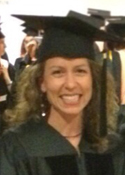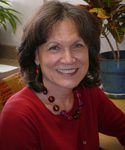 Anna Briggs, PhD, MPH
Anna Briggs, PhD, MPH
What was your educational and work experience before enrolling in the doctoral program?
I came in with a Masters in Public Health in Occupational and Environmental Health from the University of Iowa, as well as 3 years of work experience as a research study coordinator at the University of Minnesota.
What made you interested in the field of occupational health services research and policy?
Mainly because it is a “hybrid” type of program focusing on both occupational health and safety, as well as health services research and policy. I was unable to decide between the two, and with this program I didn’t have to!
What made you choose the University of Minnesota for your doctoral training?
I chose a job as a research coordinator over a public health department job because the University of Minnesota offered education benefits to full time staff. After working for a few years as a research coordinator at the University of Minnesota, I explored doctoral programs, and the MCOHS program in OHSRP was a perfect fit based on my education and career goals.
What jobs or internships were you able to work while working on your degree?
I continued to work the full time research coordinator position concurrently at the University of Minnesota for the first 2 years of my program, and then as I progressed, reduced my hours to 50% for the remainder of the program. During the second 2 years of my program, my advisor facilitated the opportunity to for me to collaborate with the Mountains and Plains ERC to work on the Occupational Health Indicators surveillance project to gain experience in secondary data analysis and occupational health surveillance. My advisor also leveraged her network to collaborate with a researcher at HealthPartners Institute for Education and Research where I was able to obtain a secondary data set for my dissertation research.
After I finished coursework, and was finalizing my dissertation research, I obtained a paid internship at a consulting firm working on the America’s Health Rankings® project.
What type of job would you like to find when you finish your degree (or describe your current position)?
Since I finished my degree in January 2014, I obtained a part-time research assistant position at Allina Health within the Division of Applied Research. Since then, the position has evolved into a full-time position where I provide consultative services to various Clinical Service Lines within Allina on research-to-practice methodologies and improving quality and efficiencies related to high quality care delivery. As my role evolves, it will include consultation within sub-divisions of Allina Performance Resources, including Occupational Health and Safety.
As an aside, the Director of Applied Research changed the design of her workstation as a direct result of a presentation I gave on my dissertation research and I’m in communication with the a manager in supply chain management who is pilot testing sit-to-stand workstations in an effort to increase movement among sedentary employees.
Furthermore, I will co- teach a short course on employee health promotion with the goal of diffusing Total Worker Health (TWH) concepts for the University of Minnesota’s Public Health Institute.
What would you say to a student considering the program?
If you come into the program with a broad focus, make sure to narrow it down as much as possible to an answerable research question, with smaller key questions. Although you will likely save the world someday, you will not (likely) be able to do it with your dissertation alone – so just contribute as much as you can within a reasonable timeframe so you can set the pathway for future brilliance. Furthermore, you are not supposed to know how everything “works” within a PhD program – everyone’s program is different and sometimes you will feel like you’re going in circles, but trust that your advisor and committee will get you through to the end. Also, take advantage of opportunities as they come about – embrace discomfort in topics you don’t think you’re interested in – you will likely learn something new can be applied to your current field of interest, making it all the more interesting and meaningful.

 Adrienne Landsteiner, PhD, MPH
Adrienne Landsteiner, PhD, MPH Helen Parsons, PhD, MPH
Helen Parsons, PhD, MPH Tammy Schult, PhD, MPH
Tammy Schult, PhD, MPH



